Last Modified on January 21, 2025
Well, has everyone moved to GA4?
After the latest iteration of Google Analytics finally migrated, marketers started buzzing with anticipation of improving their new Analytics data.
But what exactly does GA4 bring to the table, and what challenges does it present?
Join us as we dive into the Google Analytics 4 pros and cons of this new data frontier and uncover its potential impact on your digital strategies.
In this post, we will explore:
- What are the Differences Between GA4 and Universal Analytics
- Pros: GA4 Benefits Compared to Universal Analytics
- Cons: GA4 Limitations
What are the Differences Between GA4 and Universal Analytics?
The official Google documentation offers a detailed comparison of these two models, but we’ll summarize it.
Let’s start with the fact that GA4 is a qualitatively new stage in the development of analytics. It proposes a new data collection structure, which entails several further changes.
The biggest difference is that Google is moving away from a measurement model that is primarily focused on sessions and page views.
1. Data Model
The data model in Google Analytics 4 has changed dramatically. Now a lot of attention is paid to users and events.
Every interaction, including page views, is classified as an event. In addition, you can add 25 custom parameters to each event.
In Google Analytics 4, user actions are recorded automatically – unlike Universal Analytics, where all these actions were taken into account by triggering events that were configured manually.
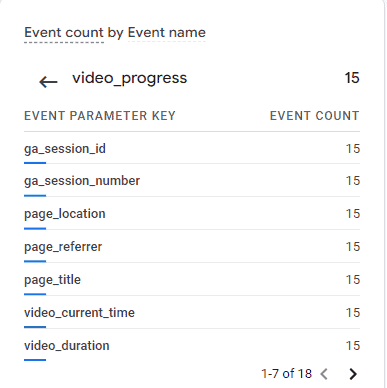
2. Account Structure with Data Streams
The structure of your Analytics account has changed, and now there is no such thing as a view. Accordingly, there are no View filters either. In Google Analytics 4, you have Accounts, Properties, and Data Streams.
In Universal Analytics, you needed to create separate properties for websites, iOS, and Android apps.
Of course, you can also create summary ones only if you use Google Analytics 360, which is far from ideal and is only suitable for large companies with an extensive budget.
In Google Analytics App + Web, you can set up multiple data streams and view aggregated reports for free:

3. Enhanced Reporting in GA4
GA4 offers a wider set of predefined enhanced reports.
This feature allows you to immediately enable the collection of data on various user actions on the site (scrolling pages, searching the site, downloading files, etc.).
The main thing is that you do not need to change the site code. The Google Analytics tag will start working without your intervention.
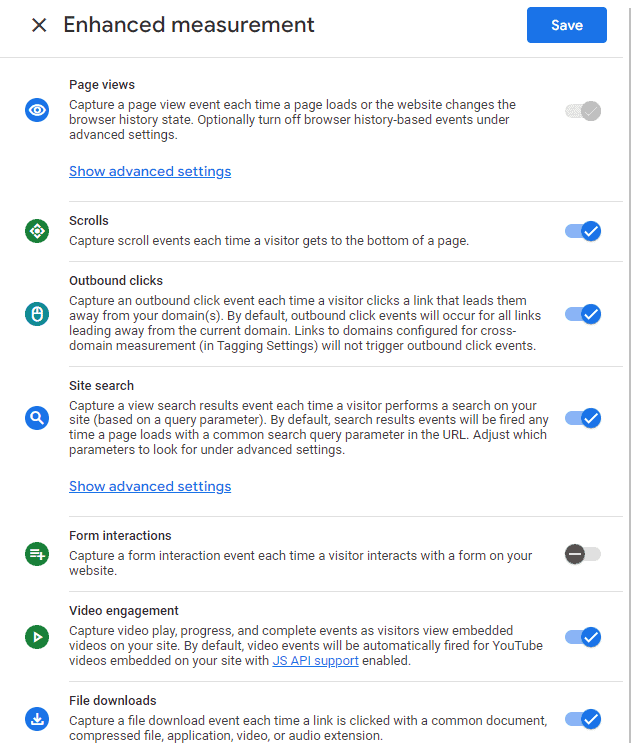
GA4 has flexible reporting configuration and custom conversion funnels that make your data visualization perfect to analyze.
For example, you can easily configure your custom reports with different visualization types within Explorations.
You can also use pre-built reports that contain more detailed and valuable metrics for analysis, such as conversion paths report, attribution model comparison, or user retention overview reports.
4. IP address anonymization
In GA4, anonymization is enabled by default and cannot be disabled.
In Universal Analytics (UA), the IP address is partially anonymized, while retaining some identifying information.
In GA4, the IP address is processed and stored as a hash value to better anonymize and protect user privacy.
5. Historical data limitation
In UA, it was possible to set an unlimited storage period for restoring data. The new GA4 does not have this feature. The maximum storage period is 14 months.
💡 Top Tip: If you need long-term historical data, you should use a store like Google BigQuery.

These two different approaches to web analytics require a lot of time for specialists to study and reconfigure systems.
That is why most marketers have used both versions of Google Analytics in advance, compared the data, and created a new system that matches all their requirements.
Let’s discuss the GA4 pros and cons we have seen during this testing period.
Pros: GA4 Benefits
Although marketers initially had negative feedback about migrating to a new version of analytics, the advantages have become more visible over time.
We have chosen a short list of improvements that we liked the most in the new version of analytics.
1. Cross-platform user identification
This aspect means that the system links user sessions at different times from different devices and different browsers.
For example, today you went to the site from a mobile device, a few days later from a desktop, and a couple of days later you looked into the application. GA4 will understand that you made all these sessions.

Or, let’s say that you have a landing page and several sites are connected. If one user makes purchases on each of them, these actions will be tied to one specific user.
All this improves the quality of the data and provides a single report along the entire user journey.
2. Machine learning and NLP features
Machine learning is both an advantage and a disadvantage at the same time. GA4 uses machine learning to fill in the gaps and improve the accuracy of the data we lose annually.
Restrictions on data collection, privacy rules such as the GDPR, and ad blockers have led to data quality deteriorating significantly. That is why the new generation of analytics is so actively implementing machine learning algorithms.
The advantage is that, for example, we can predict the likelihood of conversions based on this data. The negative side is that we do not understand how the algorithms work, and in most cases, we simply have to trust the system and algorithms.
GA4 will be able to create audiences from users who are expected to make a purchase or even generate the most revenue in the next 28 days, granted that you have enough collected data to make these forecasts and allow algorithms to make these predictions.
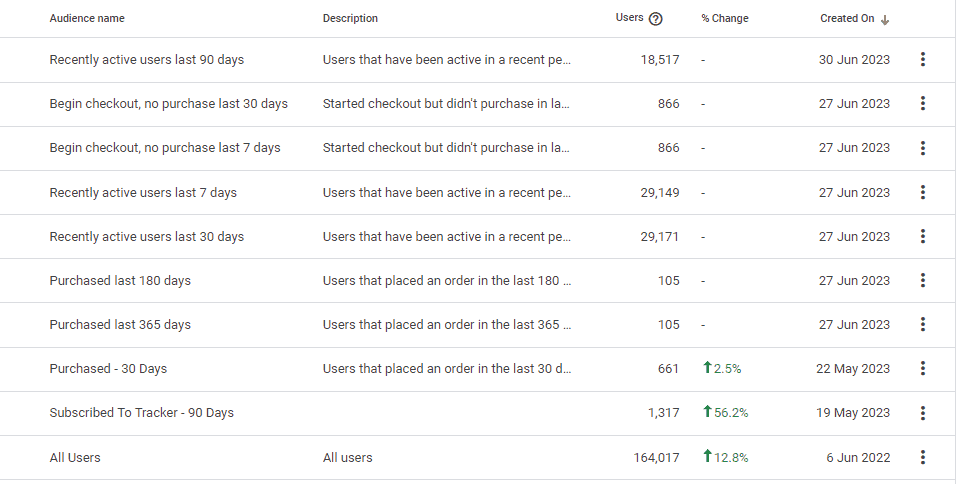
Anyway, there are a lot of cool predefined audiences that can be imported to Google ads like Users who added items to a wishlist or Users who added items to their cart without purchasing.
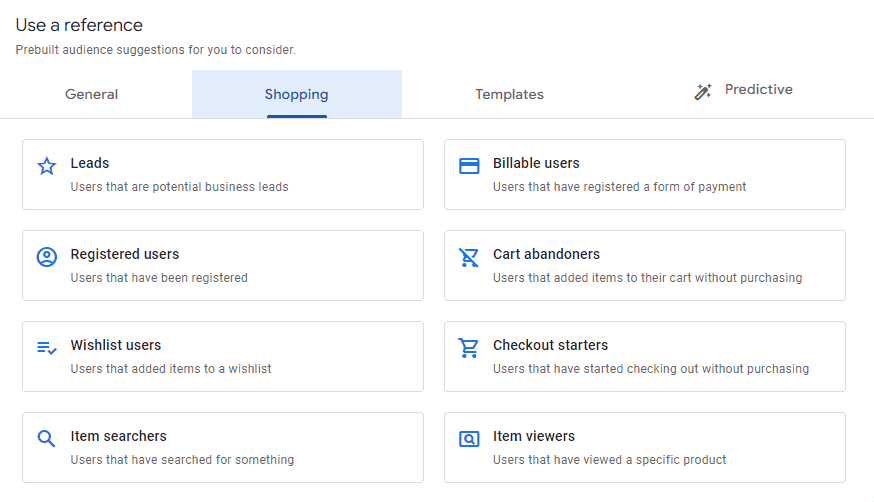
3. Explorations in GA4
Even though in UA there were more than 80 reports grouped into 5 large categories, in GA4, there are only about 20 standard reports.
However, there are Explorations. The Exploration section is a data tool in Google Analytics 4 (located in a separate category) that allows you to analyze the information received about your users in a much deeper, more detailed, and more flexible way than standard reports.

These top 10 GA4 exploration reports with use cases help you to learn about this awesome tool.
4. Funnels
With the Funnel exploration report in Google Analytics 4, online marketers are no longer limited to eCommerce funnels and shopping behavior reports during checkout, as in Universal Analytics.
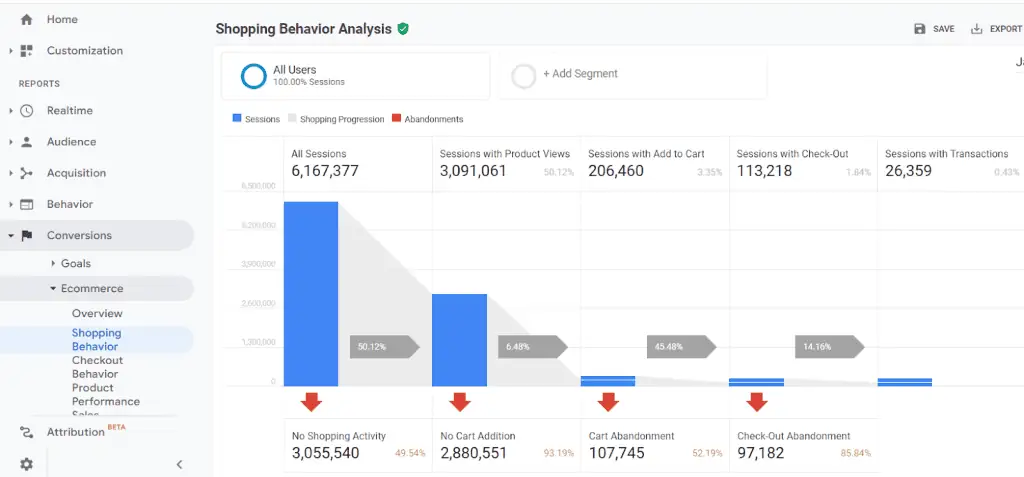
Now you can create more flexible user paths including tracked events, analyze them, segment them, and break them up using multi-stage sequences.
All this can be done not only within one session but within multiple sessions, which is an undoubted advantage of GA4 compared to UA, in which we were limited by the Sessions everywhere.
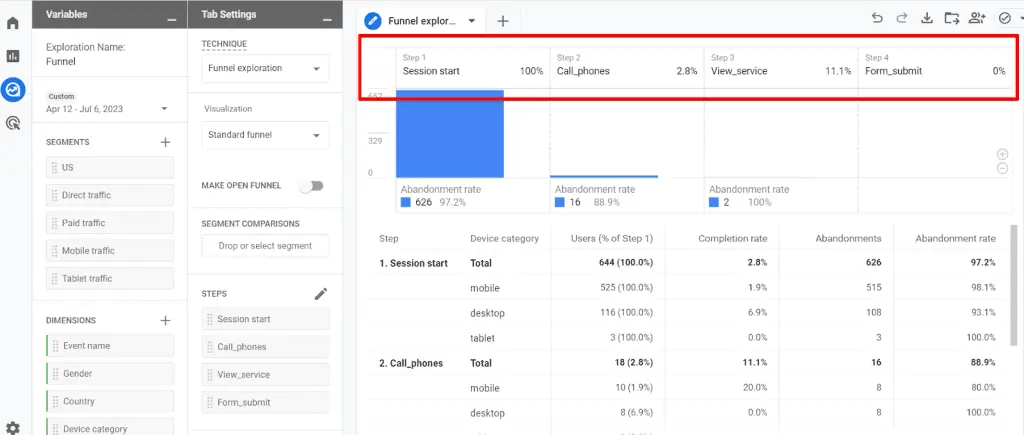
Also, the main advantage of funnel data in GA4 is the ability to build a funnel report based on historical data, which could not be done in UA.
5. Audience Triggers
Audience triggers help generate an additional event when a user enters an audience that matches a set condition.
Examples of such could include initiating a certain number of sessions, viewing a certain number of articles, or passing a conversion threshold you set.
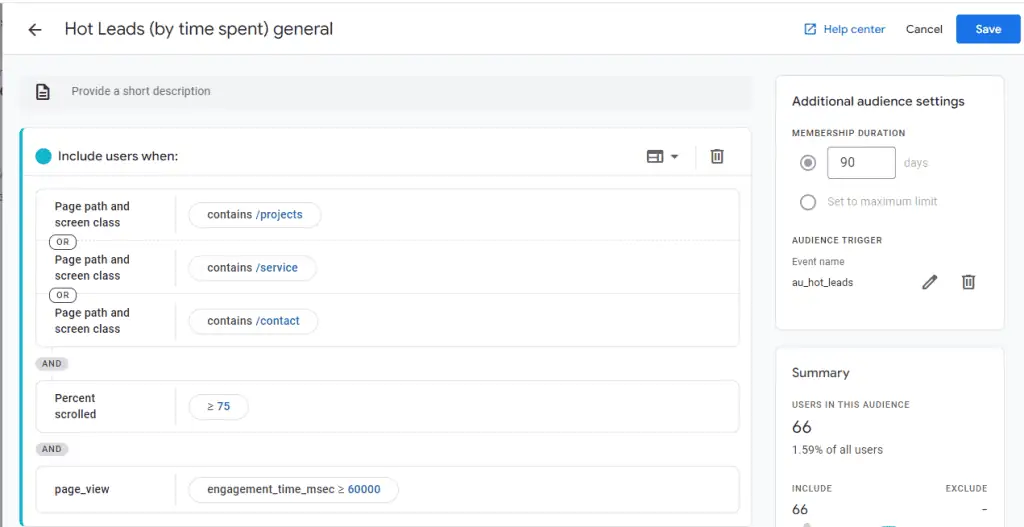
This additional event can be marked as a conversion. In total, you can create a maximum of 20 audience triggers per resource.
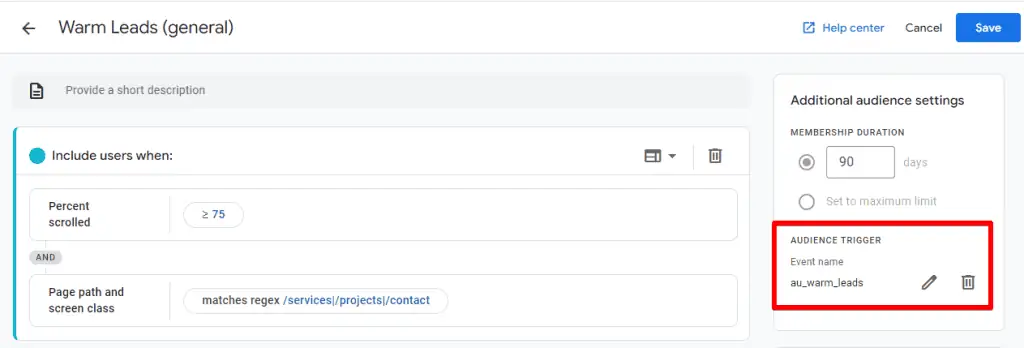
6. DebugView
The debugView tool is an excellent helper in GA4 that can debug events and track user interactions with your website or mobile application in real-time.
With it, you can check the accuracy of the data transfer of custom dimensions, metrics, and user parameters in Google Analytics 4 much faster, as well as detect errors in various tracking settings.
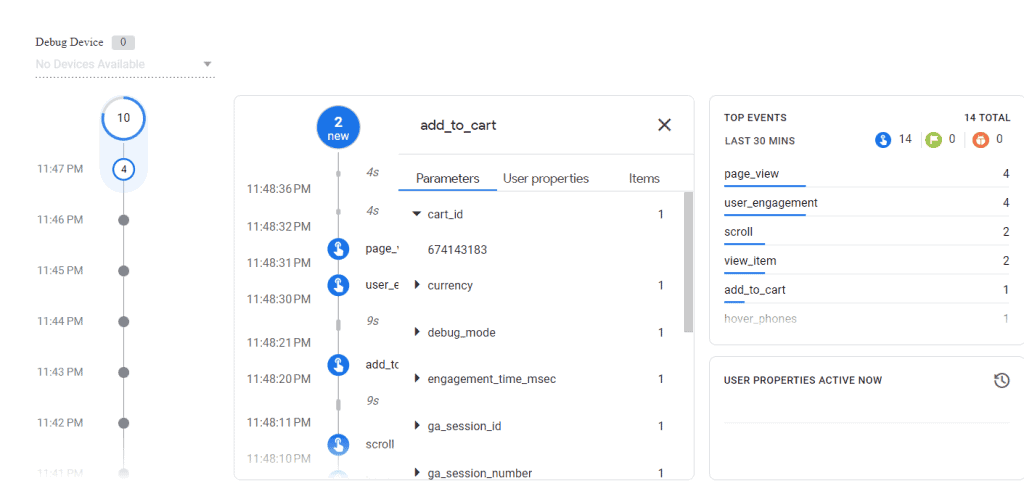
There are many more advantages to the new analytics than we have presented in this list. We believe that the new GA4 is more about customization for business needs and not about templates and standard reports.
Here is a short case of custom usage of GA4 based on business goals.
7. Customization of GA4: Case Study
We will create a custom report in the Explore block and share it with other reporters in the Reports block. For example, you can create a custom funnel report and make it appear in your left panel.
Step #1
After creating our custom report in the Exploration section, we save the report to the library.
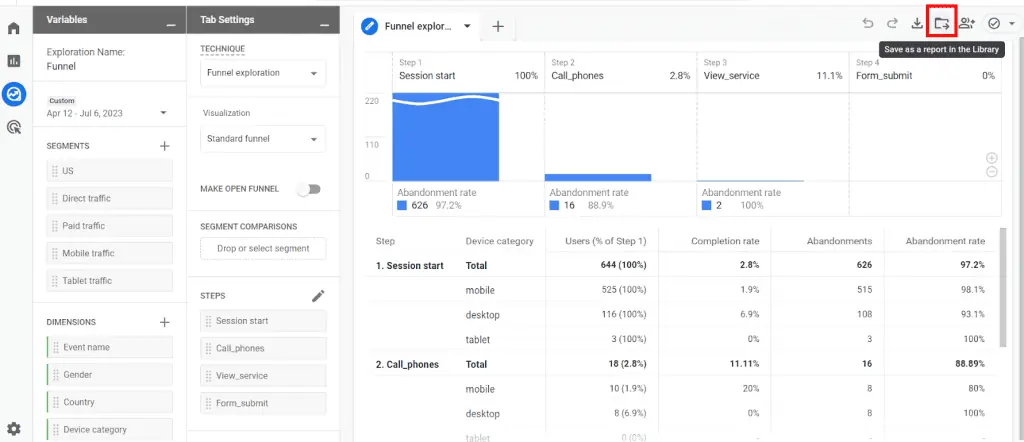
Don’t forget to name the report that will be displayed in Collections. We left the title by default in the exploration section to show you.
Step #2
Then, we add the report to the collection we need and then publish the collection.
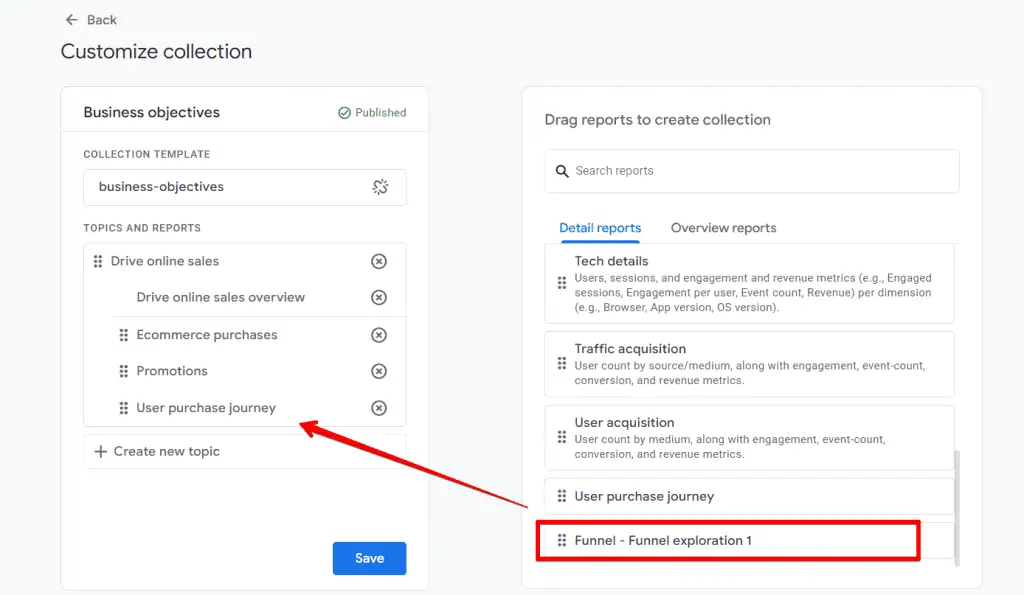
Step #3
Now, enjoy the custom funnel and any report on the sidebar according to your business needs.
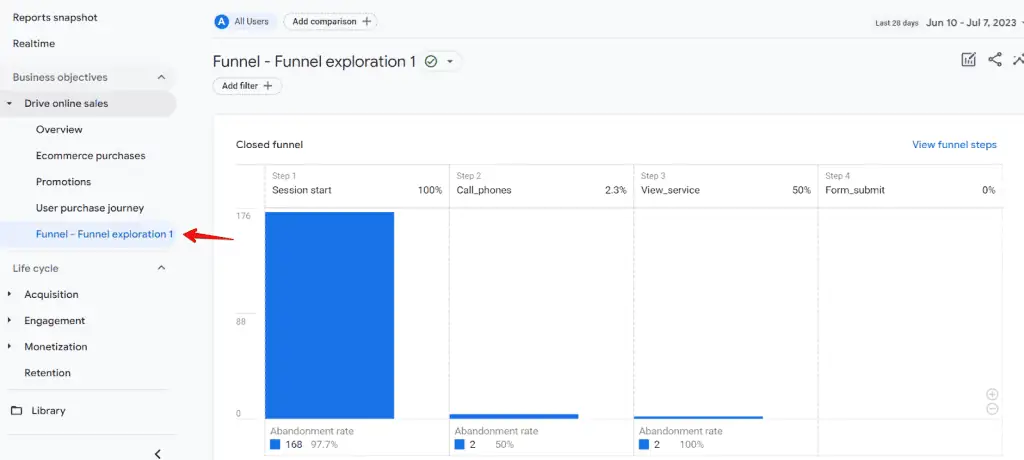
Cons: GA4 Limitations
During the initial stages of beta testing Google Analytics 4, many marketers, analysts, and SEO specialists didn’t trust it.
Google quickly stopped Universal Analytics and focused on GA4, which made companies switch to the new product. Now, the migration process is completed. Universal officially stopped processing new data.
However, GA4 still seems to be an incomplete version compared to the previous one.
1. New interface
Let’s start with the basics.
The changed reporting and measurement technology introduced in Google Analytics 4 makes navigating and collecting information difficult.
The main menu looks simpler, but you may have difficulty with tracking updates, reports designing, etc.
In addition, now you have to work with data streams. Data flow refers to the source of information from which the metrics come, which can be a website, an iOS app, or an Android app.
In GA4, you can set up data filters, but now they are applied directly to the data stream. This means that it is impossible to create reports for a specific view containing a limited amount of data.
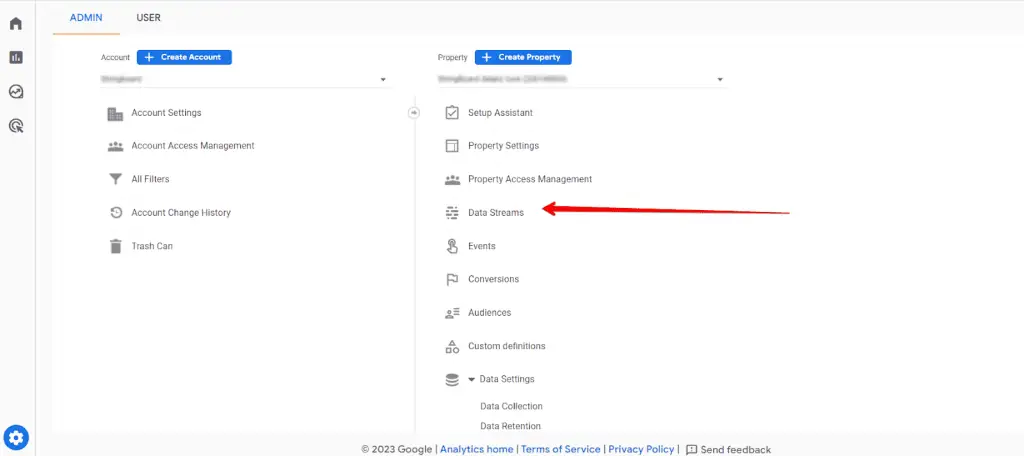
2. Limited Metrics and Reports
One of the drawbacks of GA4 is that it has a different way of handling data compared to UA. While UA focused on sessions and page views, GA4’s measurement model is purely event-based.
GA4 does offer some alternative metrics like the number of engaged sessions, average engagement time per session, and engagement rate, which can be useful for understanding user behavior.

However, the downside is that these metrics are entirely new, which means you can’t compare them to previous data if you haven’t used them before.
You’ll need to adjust to the fact that the default reports available in UA are no longer present in GA4. For instance, GA4 only provides three types of engagement metrics reports, whereas UA had around 30.
Furthermore, a few key features are missing in GA4 reporting.
For instance, you won’t find regular expressions in parameter filtering, or metric filters in standard reports (only in Explorations), and there are no segments in standard reports (although there are limited comparison capabilities).

One of our favorite little features is also missing – special annotations. Annotations helped us record certain events on the site that affected traffic or user behavior. Unfortunately, this feature is not available in Google Analytics 4.
🚨 Note: Annotations have been added to GA4, check the feature out here.

💡 Top Tip: You can use some Chrome extensions like Crystals Ball.
3. Privacy Vulnerabilities
There are significant data privacy concerns when it comes to using Google Analytics 4. Unlike Universal Analytics, which relied on cookies and JavaScript variables to track page views, GA4 tracks events instead.
However, GA4 still utilizes tracking cookies, which means you’ll need to include a cookie consent banner on your website to activate GA4 tags and gather user data.
So, what are the risks?
By default, Google continues to collect data even if a visitor has explicitly opted out.
According to European legislation regulations, websites must obtain clear consent for processing personal data. Failing to adhere to this requirement can lead to hefty fines or even legal consequences.
To mitigate these risks, companies need to revise their privacy policies and make significant technological changes to comply with GDPR requirements.
4. Challenges in Adapting to the New Platform
Transitioning from UA to GA4 can be a time-consuming process that requires a significant learning curve. Unlike UA, GA4 requires more manual adjustments and customization, demanding strong analytical skills and a deep understanding of data analysis.
You’ll need to become familiar with the GA4 interface, explore new metrics, and determine where and how to find valuable insights.
Since GA4 offers limited pre-built reports, many users turn to third-party services like Looker Studio (formerly Google Data Studio) or export data to BigQuery to create customized reports. This means you’ll also need to acquaint yourself with these new tools.
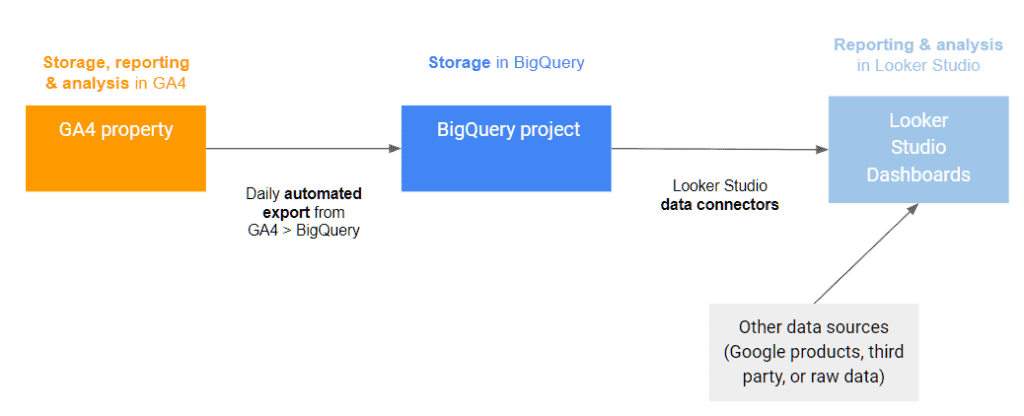
This concentration of effort may pose challenges for smaller organizations that don’t heavily rely on data and lack the resources to set up and maintain a complex tool like GA4.
Summary
So, we have already moved into the new era of GA4 – there is no turning back. Therefore, the winner is the one who knew in advance about the shortcomings of the platform, has adapted to them, and has mastered the new tool.
On the other hand, those who are just implementing analytics will immediately see a new measurement model with several advantages, which we have discussed.
GA4 is a new level in analytics, a new approach dictated by the change in user behavior and allowing us to make data visualization due to business needs. It enables us to customize the tool and create unique dashboards.
New changes are always difficult to accept, but adaptation and working with a new tool will benefit you and help you find new growth points. Start with migrating data, if you haven’t done it yet.
If you’re new to Analytics, consider yourself fortunate because you don’t have to unlearn anything.
Please share your thoughts in the comments section. Which would you prefer: having prior knowledge of the previous version of analytics, or starting fresh?





